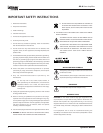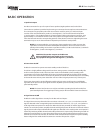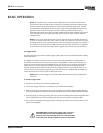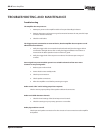
DD-8 Power Ampliers
Operation Manual10
BaSIc operatIon
7. Speaker Outputs
Provides connection for up to four pair of stereo speakers (eight speakers total) to the DD-8.
Connection to speakers is provided via phoenix-type connectors that accept bare wire terminations.
The connectors are grouped in pairs with one connector each for pair A, B, C and D. Each pair
consists of four wire terminations: positive (+) and negative (–) for the Left channel and positive
(+) and negative (–) for the Right channel. To attach speaker cables to the phoenix connector, strip
approximately ¼” of insulation o of the end of the positive and negative leads of the cable and
insert the bare ends into the corresponding position of the phoenix connector, tightening the screw
terminals on top to secure the termination. Repeat this procedure for each speaker.
NOTE: It is recommended to use 16-gauge or larger speaker wire in order to ensure low-
impedance connections between the amplier and speakers. Be sure to observe correct
polarity when making connections to speakers: Positive (+) leads to the Positive (+) terminals
and Negative (–) leads to the Negative (–) terminals.
8. Power Save On/O
Enables the extreme low-power automatic standby mode of the DD-8.
The DD-8 is a highly ecient design with lower-than-average power consumption at standby, idle
and in normal operation mode. The Power Save mode can be enabled to lower standby power
consumption even further by disabling all circuitry except that required for the front panel standby
button. If the Power Save switch is set to the On position, the DD-8 will automatically revert to standby
and enter this extreme low-power state after one hour without signal present at any of the inputs.
If the Power Save switch is in the O position and the DD-8 is active, it will remain on indenitely
regardless of the presence of input signals until the amplier is put into standby mode via the front
panel standby switch.
NOTE: The Power Save function can only be used when operating the DD-8 from the front
panel standby button. If a trigger input is being used, it will override the Power Save function.
9. Signal Sense On/O
Enables the audio Signal Sense circuitry for the Bus and Local inputs.
The Signal Sense circuitry allows the DD-8 to activate a channel (1, 2, 3, 4, 5, 6, 7 or 8) when an audio
signal is detected at the corresponding input and deactivate a channel (1, 2, 3, 4, 5, 6, 7 or 8) when no
audio signal has been present for 30 minutes. When the DD-8 is powered on and the Signal Sense
switch is set to the On position, amplier channels with signal present will be active. Channels without
signals present will remain switched o until signals are detected. In this mode, power consumption is
lowered by switching o idle channels and audio performance is improved by eliminating crosstalk on
adjacent unused channels. In cases where Signal Sense is On and no audio signals are present on any
channels for more than 30 minutes, all channels will be switched o and only the front panel standby
button will glow blue while the DD-8 continues to monitor all inputs for a signal.
CAUTION: The speaker outputs on the DD-8 are
balanced (dierential) and should not be connected to
any equipment that grounds the Negative (–) terminals.


















